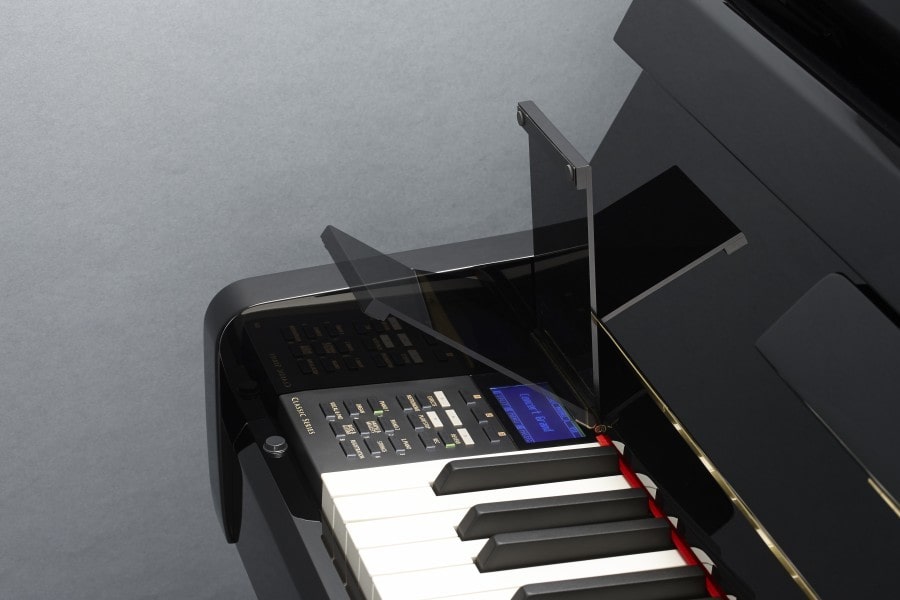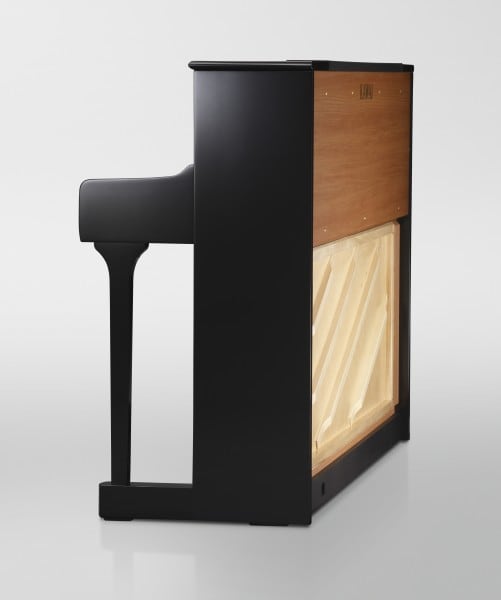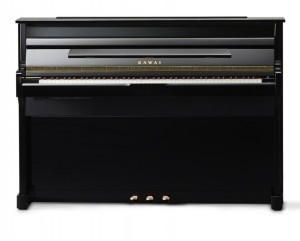Kawai CS10 Review: The Top Choice Of Premium Digital Pianos
 Hi, I’m Stu Harrison, and I’m here at Merriam Pianos in Oakville Canada, just outside of Toronto. We’re going to be looking at Kawai’s new upright piano, the Kawai CS10. Now it sounds great, and looks great, but one thing that is not going to be immediately obvious is that the CS10 is actually a digital piano.
Hi, I’m Stu Harrison, and I’m here at Merriam Pianos in Oakville Canada, just outside of Toronto. We’re going to be looking at Kawai’s new upright piano, the Kawai CS10. Now it sounds great, and looks great, but one thing that is not going to be immediately obvious is that the CS10 is actually a digital piano.
The Kawai CS10 is part of a whole new class of digitals that the industry is starting to experiment with. They call it the “hybrid” piano, and the reason they call the hybrid is because it’s combining elements of the acoustic piano world and elements of the digital piano world. And with the CS10 Kawai has reached a whole new level of this combination. Just like any digital piano I tend to be pretty critical, and there’s a few ‘must-haves’ that I am always looking for:
– how it feels
– how it sounds
– am I able to get a really authentic response of the instrument,
– the packaging/look; is it easy to use, how is the interface, how does it look in the home or studio
 To be honest, the Kawai CS10 was an instrument that we did not expect to get a lot of attention, because from a price point standpoint, were well into the acoustic range. This is not a starter level instrument by any means. But when we started looking at the traffic coming to our website, we realized that the CS10 was actually getting almost as much visitor traffic as some of our $1000 keyboards! People were really quite captivated and intrigued by this concept, so in response, we’re doing this write-up for you today!
To be honest, the Kawai CS10 was an instrument that we did not expect to get a lot of attention, because from a price point standpoint, were well into the acoustic range. This is not a starter level instrument by any means. But when we started looking at the traffic coming to our website, we realized that the CS10 was actually getting almost as much visitor traffic as some of our $1000 keyboards! People were really quite captivated and intrigued by this concept, so in response, we’re doing this write-up for you today!
Lets start by talking about the keys, and the action. In most digital pianos, the action is made almost entirely of plastic, and consists of counterweights, springs…really what they’re trying to do is make use synthetic and lighter, cheaper materials to simulate how a real acoustic piano key feels. Kawai, several years ago, started experimenting with the idea of using a real acoustic piano key, rather than simulating one, as a way to better mimic the feel of a piano. The action that Kawai is putting in the CS10 is called the “Grand Piano Feel” action, and this is something that is very very similar to the RM3 action from a few years ago. The reason for the Kawai’s CS10’s success in getting such a great touch is that all the fundamental geometry is the same as an acoustic: the distance from the front rail to the balance rail is the same (between the Kawai CS10 and acoustic); the distance from balance rail to cap-stand is the same (between Kawai CS10 and acoustic); it is entirely gravity fed rather than working off a spring, and there are no hinges or excessive use of plastics to breakdown over time. The triple sensor is there to ensure absolute accuracy and deliver pinpoint precision to the computer .
This has several benefits; one drawback that plastic actions have traditionally had is that over time that plastic tends to dry out. Sometimes it can shrink and subsequently starts to click (as gaps open up) and often leads to permanent and uneconomical damage.
I like the approach – graded hammer actions, like the kind that 99% of all digital pianos have, are certainly getting more and more authentic-feeling. But many are not exactly right, and they totally pale in comparison to the durability of an acoustic action. Kawai’s CS10 on the other hand just sticks a true acoustic key in, with the same geometry, and goes from there. No simulation – just the real deal.
I have made the mistake before of ‘over-hyping’ actions, so I’ll throw out a few caveats. One, action preference is SUBJECTIVE, and even if an action feels good to me for quantifiable reasons, it doesn’t mean the next guy is going to feel the same thing. TWO, let’s keep this discussion within a reasonable perspective. This is not a 9′ Concert Grand action in a $7000 digital piano – let’s be realistic. However, I can tell you that it’s legitimately as good as a 46″ upright: certainly amongst the absolute that the digital industry has ever produced.
 The second topic to cover is sound. Kawai’s been experimenting with the technology called ‘modeling’ for several years now, and it’s one of their most successful tone engines. The version which the CS10 uses is called Harmonic imaging XL, and it’s a pure synthesis of both modeling technology and sampling technology. Sampling is essentially when you take a fixed audio snapshot of a real piano sound, and then replaying it when triggered. In othe rwords, you record a piano note, and then playing the key is like a ‘play-stop’ button. Modeling on the other hand is real-time generation of the sound, using computer algorithms – almost like if you were playing a videogame and you are seeing the graphics being rendered in real-time versus just having a movie playing back.
The second topic to cover is sound. Kawai’s been experimenting with the technology called ‘modeling’ for several years now, and it’s one of their most successful tone engines. The version which the CS10 uses is called Harmonic imaging XL, and it’s a pure synthesis of both modeling technology and sampling technology. Sampling is essentially when you take a fixed audio snapshot of a real piano sound, and then replaying it when triggered. In othe rwords, you record a piano note, and then playing the key is like a ‘play-stop’ button. Modeling on the other hand is real-time generation of the sound, using computer algorithms – almost like if you were playing a videogame and you are seeing the graphics being rendered in real-time versus just having a movie playing back.
Harmonic Imaging UL combines both; its using sampling, which is a fantastic way to reproduce the fundamental tone. It uses the modelling to reproduce the upper harmonics, which has always been a serious weakness in most digital pianos. The CS10 uses an incredibly complex algorithm to generate those, and on top of that, the computer is powerful enough that on top of being able to get all of those upper harmonics happening, it still has a polyphony of 256 which is industry-leading.
What is truly unique about the CS10 is how it delivers that sound to you. The majority of the sound on the CS10 is not coming to me through speakers; the majority of it is actually coming through a real solid spruce soundboard. How they do this is a series of magnets on the back are actually connected to a bridge system which then drives that soundboard and makes it behave truly like a transducer – no different than the front of a guitar word or of course an acoustic piano soundboard. So when I’m playing something, I’m getting unbelievably authentic acoustic sense, because most of the sound is traveling through real wood. You’d be surprised at how much it filters out the digital’ness’ that you get even from very very high-end instruments.
Third thing I mentioned is the aesthetic, and to be honest, I don’t know how you can beat this. Close the lid, and you got exactly the same casing as Kawai applies to their K 200 award-winning acoustic upright piano. To all but the most trained eye, this is going to look like – and feel like – a real acoustic piano in your home.
So if you’re somebody who has a restriction on what type of instrument you can put in your home – perhaps humidity control is a major challenge, or like many of us, you’re now living in a town-house or condo and need to be very mindful of sound your neighbors – an instrument like this is going to give you the pride and satisfaction of owning a really fine instrument. But now you’ve got all the advantages of a digital piano. It never has to be tuned, you can easily use headphones, connect your digital devices like iPad’s or computers, and it’s even got the ability to customize the piano through feature on their called “virtual technician”.
I’d really encourage you to come down and have a look at the Kawai CS10; to most people who sit down at the instrument, it’s a revelatory experience. They can not believe how far digital pianos have progressed, and this is as good as it gets right now.
For detailed specs and pricing please visit: https://www.merriammusic.com/product/kawai-cs10-best-digital-piano/
For More Great Reviews Please visit our Piano Review Page:


